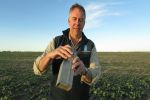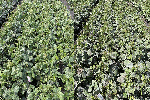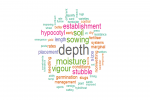-
 Pests, 21 Dec 2023
Pests, 21 Dec 2023Keep harvest clean and carry on monitoring
Although mouse numbers across the northern region are low, growers should aim for a clean harvest and continue monitoring to ensure mouse numbers stay where they are.
-
 Pests, 15 Nov 2023
Pests, 15 Nov 2023Unpacking pest’s flower fascination helps build defensive strategies
Understanding why pigeon peas are so susceptible to Helicoverpa armigera is the first step in building crop defences and boosting summer crop options for northern growers. Research scientist Trevor Volp is building a greater understanding of this behaviour and identifying potential crop defence traits.
-
 Pests, 07 Nov 2023
Pests, 07 Nov 2023Reduce harvest losses to minimise mouse risk
Grain growers urged to minimize harvest waste to improve baiting against low mouse activity, enhance profitability. Expert advice from National Mouse Group backed by GRDC research.
-
 Pests, 25 Oct 2023
Pests, 25 Oct 2023Common misunderstandings surround phosphine fumigation
Powered fumigation recirculation boxes for large silos aim to allow phosphine to be applied at ground level and distribute gas through the storage more evenly. Recirculation can also be achieved safely and effectively by still applying the phosphine in the storage headspace and using a small fan plumbed between the headspace and base of the silo to recirculate gas.
-
 Pests, 28 Sep 2023
Pests, 28 Sep 2023Mouse tracking project in WA
A project to track mouse populations in the WA grainbelt is helping to understand mouse outbreak risks and when timely baiting is needed
-
 Pests, 15 Sep 2023
Pests, 15 Sep 2023Bait spreading methods examined to combat mouse damage in crops
With Grains Research and Development Corporation (GRDC) investment, the project – Guidance for spreading mouse bait to improve efficacy and maintain bait integrity – is examining mouse bait application techniques to better understand the performance and likely efficacy of various options.
-
 Pests, 13 Sep 2023
Pests, 13 Sep 2023Northern NSW growers urged to check winter crops for Russian wheat aphids
The experienced scientist is urging growers and agronomists to monitor crops for RWA, and use the RWA action threshold calculator, to help determine the cost effectiveness of chemical treatment.
-
 Pests, 11 Sep 2023
Pests, 11 Sep 2023Strategy a part of managing snails after liming
Some growers have noticed snail numbers increase after liming. Lime is a source of calcium which increases shell strength and fertility. As a result of this observation, a small research trial was conducted to gauge the impact liming had on snail fertility and shell strength, and whether incorporating lime or using a different type of lime could limit snail population growth.
-
 Pests, 03 Aug 2023
Pests, 03 Aug 2023Does it pay to treat fall armyworm?
Economic thresholds and guidelines are being established so growers can decide when to treat fall armyworm.
-
 Pests, 06 Jul 2023
Pests, 06 Jul 2023Partnerships focus on targeted pest research solutions
The Australian Pest Genome Partnership has prepared its first 28 genomic datasets and will soon make these assets publicly available to organisations interested in researching ways of controlling some of Australia’s top pest and invasive species. The datasets include mosquitoes, khapra beetle, cane toads, fall armyworm, foxes, feral pigs and cats, as well as weeds such as wild radish, rye and rat’s tail grasses.
-
GRDC News
+
GRDC News

Growers given edge in rust ‘arms race’
Grain growers will maintain access to wheat varieties with rust resistance and be able to...

QLD grain grower new GRDC board director
GRDC has welcomed the appointment of well-respected Queensland grain grower Andrew Earle as the organisation’s...

Industry consultant honoured with GRDC award
The 2025 northern GRDC Seed of Light has been awarded to Independent Consultants Australia Network...

Victorian agronomist and scientist each win grains award
Agricultural consultant Cam Nicholson and research scientist Dr Audrey Delahunty each received awards this week...

Acid soil research priorities identified
A National Soil Acidity Workshop held in Adelaide in February has identified and prioritised transformational...

GRDC regional Updates to kick off in Cunderdin
Western Australian grain growers can learn about the latest research and innovations relevant to their...

Strategic grazing with virtual fencing a viable potential weed control option
Targeted grazing using near-commercial virtual fencing devices has emerged as an effective weed control solution...

Making sense of the weather
Recent investments by GRDC in enhanced seasonal forecast information have resulted in a productivity boost...
ADVERTISEMENT -
Agronomy
+
Agronomy

Impact of NVT extends beyond variety selection
The National Variety Trials (NVT) system adds value to the agricultural research pipeline in ways...

Celebrating 20 years of GRDC’s National Variety Trials
Established by GRDC in 2005, NVT has evolved into the largest coordinated variety trial network...

Advancing cereal yield frontiers
GRDC is investing in research to identify agronomic tactics to help growers achieve yield potential,...

The quest for the perfect rhizobia–legume matches
GRDC has made a groundbreaking investment in creating the world’s largest collection of rhizobia, significantly...

Frost research set to target ear architecture
After many years of hearing stories about wheat varieties with different-shaped ears being more tolerant...

Cell membranes key to promising frost approach
The ability of plant cell membranes to flex instead of breaking or bursting at low...

To plant, or not, on late summer rain?
Higher returns are possible from a farming system that can flexibly optimise sowing opportunities throughout...

Managing waterlogging is a long road travelled
Working with South Coast NRM on a GRDC-supported National Grower Network project, the Marold family...

World-first solution to combat spray drift saves growers time, money
The Weather and Networked Data (WAND) system, a pioneering Australian-developed weather data technology, has been...

Waving a WAND to boost spraying certainty
The Weather and Networked Data (WAND) system allows growers to plan their spraying operations with...
ADVERTISEMENT -
Grower stories
+
Grower stories

Growers warned of increased mouse activity
The National Mouse Group warns of increased mouse activity reports in the Darling Downs and...

Time to reflect as growers weigh up mostly positive harvest results
Grain growers from across Australia report on how the season is progressing as they gear...

Lessons aplenty in levelling
The benefits of levelling melon holes were discussed when the Yarrie Lake Landcare Group travelled...

Opportunity knocks for mungbeans this season
Mungbeans have been exceptional this season for south-eastern Queensland growers Peter and Kylie Bach, with...

On-farm advocacy prompts national project
Trials testing long coleoptile wheat have had an unexpected benefit, showing that deep sowing can...

Growing the scope of oats
The scope for oats is growing not only with developing health-conscious markets but also in...

Winter canola proves profitable at Weatherboard
Ben Findlay’s farm near Weatherboard, Victoria, utilises ungrazed winter canola, specifically the hybrid RGT Nizza...

Growers networking to master faba beans
Faba bean growers are tapping the experience of researchers, agronomists and fellow growers to improve...
ADVERTISEMENT -
Weeds, pests and diseases
+
Weeds, pests and diseases

Diversity is a defence against weeds
A diverse crop sequence can cost-effectively help reduce the annual ryegrass population. From 2014 to...

Planning and timing the key to hitting summer weeds
Timing is a key factor in the control of summer weeds, which should be sprayed...

Pressure building to find new control strategies for aphids
The need for an integrated strategy to control blue-green aphids has been heightened by the...

Multidisciplinary team tackles lime-loving snails
Snails are a persistent pest for grain growers in Western Australia's Albany and Esperance Port...

App helps mungbean growers manage powdery mildew
The PowderyMildewMBM app has been helping mungbean growers across Queensland and New South Wales better...

Rustproofing cereals to protect harvests
Wheat diseases cost Australian cereal growers about $1 billion a year. Stripe rust is the...

Eyes on exotic pests
Despite Australia’s stringent pre-border and border controls, exotic pests still pose a threat. Early detection...

Integrated approach to pests on-farm
To ensure pest control strategies are effective, it is crucial to diversify the approach taken...

Grains industry scores A-plus for chemical residue compliance
Australia’s grains industry has a 99.2 per cent compliance rate with national maximum residue limits...

EU changes residue limit for haloxyfop on canola
The EU has announced it intends to reduce the MRL for haloxyfop on canola from...
ADVERTISEMENT -
Crops
+
Crops

Hardy barley proves its worth in rotation trials
Long-term farming systems experiments support barley as a profitable inclusion in canola and wheat rotations

Brainstorming with other growers a path to progress
Minhamite grower Tim Whitehead has won a GRDC Hyper Yielding Crops initiative award for his...

Legumes may push a system closer to yield potential
In high-yielding environments, adding more nitrogen fertiliser may not be enough to maximise returns in...

National initiative to enhance N fixation in pulses
The National Nitrogen Fixation Project will develop superior nitrogen-fixing bacteria (rhizobia) strains for chickpea and...

Understanding canola establishment to optimise yields
Establishment of any crop is foundational to its performance and, ultimately, its yield. A major...

Enquiring attitude opens opportunities
Have-a-go attitude is surprising Chloe Rout in the avenues and opportunities it can open for...

Decline in wholegrain bread
Australian Dietary Guidelines recommend that Australian adults eat six servings of grains daily, preferably as...

Research makes strong case for early sown sorghum in the north
Dryland cropping research could see some growers continue to push the boundaries of the traditional...
ADVERTISEMENT -
Innovation
+
Innovation

Are you ready for autonomy?
With automated on-farm solutions for farm tasks now available, it is worth considering if you...

Robot sprayer proving its worth as a tireless worker
Charlie and Elsie Buchanan are using an autonomous SwarmBot to tackle weeds on their large...

Drought-tolerant crop research
A canola variety modified to tolerate the herbicide glyphosate has been placed on the Office...

120 years of wheat in 100 metres
An extraordinary set of Australian wheat varieties dating back 120 years is being grown at...

Grains steps up preparations for GHG monitoring
With the grains industry, like agriculture more broadly, facing increasing pressure to know its carbon...

Fostering high-impact innovation in heat tolerance
GRDC has long maintained an extensive investment portfolio looking to improve the heat tolerance of...

Vale Alan Robson – a champion for agricultural science
Alan Robson, foundation director of the Cooperative Research Centre for Legumes in Mediterranean Agriculture, has...

Research enthusiast sees value in ground-truthing
Seven years ago, a forward-thinking mixed farmer from southern New South Wales applied to become a...
ADVERTISEMENT -
Farm business
+
Farm business

Building resilience in a mixed farming business
As we confront changes in climate, resilience of production systems and farm businesses is becoming...

RiskWi$e headed west to talk through results and goals
The RiskWi$e team travelled to Western Australia in July, bringing together grower groups and researchers...

Ten tips to reduce the risk of harvester fires this season
Recent GRDC Harvester Set-up Workshops run across Australia’s grain growing regions have highlighted the importance...

Selecting grain protectants this harvest
GRDC's latest cereal protectants offer enhanced pest management. Key for growers: rotating Spinosad, Deltamethrin, Fenitrothion,...

Give grain storage a pre-harvest health check
GRDC Grain Storage Extension team project lead Chris Warrick said the biggest challenge of storing...

Pest resistance raising the knowledge bar for stored grain
Ongoing research highlights the growing challenge of managing stored grain pests due to increasing insect...
ADVERTISEMENT